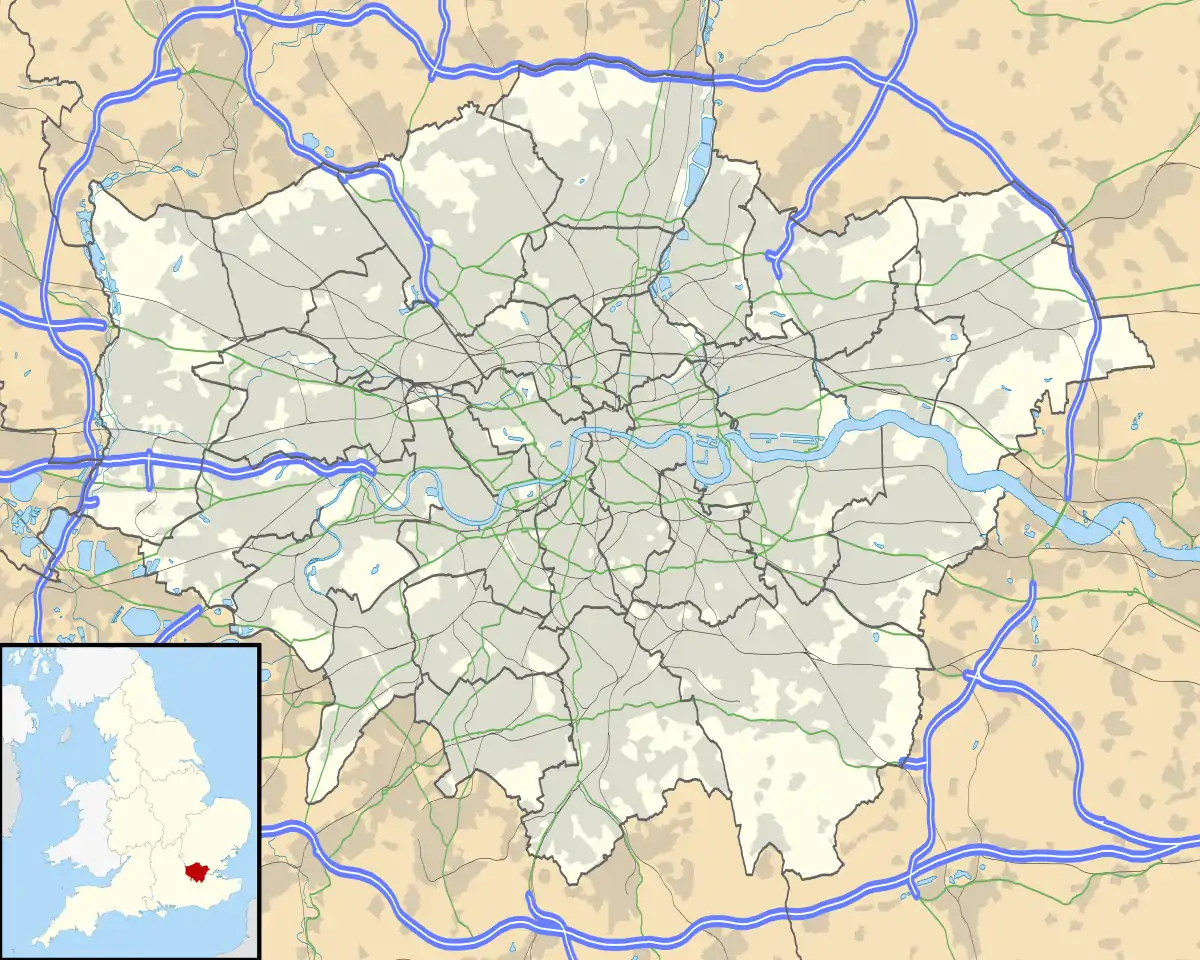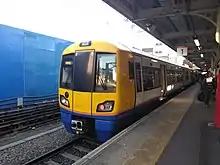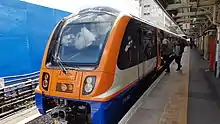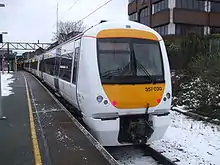Barking station
Barking is an interchange station serving the town of Barking, east London. It is served by London Underground, London Overground and National Rail main line services. It is located on Station Parade, in the town centre.
| Barking | |
|---|---|
 The station forecourt in 2004 | |
 Barking Location of Barking in Greater London | |
| Location | Barking |
| Local authority | London Borough of Barking and Dagenham |
| Managed by | c2c |
| Owner | Network Rail |
| Station code | BKG |
| DfT category | B |
| Number of platforms | 9 (facing 8 tracks) |
| Accessible | Yes[1][2] |
| Fare zone | 4 |
| London Underground annual entry and exit | |
| 2015 | |
| 2016 | |
| 2017 | |
| 2018 | |
| 2019 | |
| National Rail annual entry and exit | |
| 2015–16 | |
| – interchange | |
| 2016–17 | |
| – interchange | |
| 2017–18 | |
| – interchange | |
| 2018–19 | |
| – interchange | |
| 2019–20 | |
| – interchange | |
| Railway companies | |
| Original company | London, Tilbury and Southend Railway |
| Pre-grouping | Midland Railway |
| Post-grouping | London, Midland and Scottish Railway |
| Key dates | |
| 13 April 1854 | Opened by LT&SR |
| 1902 | District line started |
| 1905 | District withdrawn |
| 1908 | District line restarted |
| Listed status | |
| Listed feature | Booking hall |
| Listing grade | II |
| Entry number | 1242678[7] |
| Added to list | 24 November 1995 |
| Other information | |
| External links | |
| WGS84 | 51.5393°N 0.0817°E |
On the Underground it is a stop on the District line and is also the eastern terminus of the Hammersmith & City line; on the National Rail network it is served by c2c services operating to and from Fenchurch Street; and on the Overground it is the eastern terminus of the Gospel Oak to Barking Line. There is also interchange with London Buses and East London Transit routes on the station frontage.
The station was opened in 1854 by the London, Tilbury and Southend Railway as one of the first stations on the route. It was rebuilt in 1908 and again in 1959. As of February 2012, significant redevelopment of the station is currently proposed by Barking and Dagenham London Borough Council and the Department for Transport.[8]
History
The station was opened on 13 April 1854 by the London Tilbury and Southend Railway (LTSR) on their new line to Tilbury, which split from the Eastern Counties Railway (ECR) at Forest Gate. A shorter route from London between Little Ilford and Gas Factory Junction in Bow, and avoiding the ECR, opened in April 1858. A "Pitsea direct" branch was completed in June 1888 giving more direct access to Southend-on-Sea via Upminster, and avoiding Tilbury. The station was rebuilt in 1889.[9] In 1894 the Tottenham and Hampstead Junction Railway was extended by means of the Tottenham and Forest Gate Railway to join the 1854 line from Forest Gate to Tilbury. District line services initially operated over the tracks of the LTSR from 1902. In 1905 a pair of tracks was electrified as far as East Ham and the service was cut back there. It was extended back to Barking in 1908 and eastwards to Upminster, over a new set of tracks, from 1932. Hammersmith and City line, then known as the Metropolitan line, service began in 1936.
The station booking hall was completely rebuilt between 1959–61 to designs by architect H.H. Powell[10] with Project architect John Ward of British Railways Eastern Region Architect's Department.[11] Nikolaus Pevsner stated it was "erected to coincide with electrification of the railway" and that "it is commensurately modern in outlook and unquestionably one of the best English stations of this date". The station was reopened by the Queen in 1961.[12] It is now a Grade II listed building.[13]
Accidents and incidents
- In November 1923, a locomotive crashed through buffers at Barking and overturned, overhanging the road below.[14]
Design
The station has four sets of stairs from the platforms to the overbridge and the booking hall. Four ramps connected by a subway give step free access between all the platforms. The stairs/ramps access platforms: 1 and 1a, 2, 3 & 4, 5 & 6, and 7 & 8. There is a lift between the booking hall and platforms 1 and 1a. This station has two bay platforms (no 1 and 3). Platform 1 is the terminal platform for the Gospel Oak to Barking Line, and is only used by London Overground services. It was electrified in 2017 ready for the planned introduction of electric trains in 2018. Platform 3 is used by some LU trains on both lines that serve the station, but mainly the District line.
The ticket office is managed by c2c and has seven serving windows. TRIBUTE and FasTIS ticket machines are in use. Tickets are available for National Rail, as well as London Underground. Oyster Cards can also be issued at the ticket office. There are four Scheidt and Bachman ticket machines, which can issue tickets ordered on line (Tickets on Demand or 'TOD'). The S&B machines sell Oyster products. The four Shere Fastticket machines still on site as at 25 April 2018 have been taken out of service with effect from 1 April 2018, according to a sign posted on them. Seven ticket barriers and a wide ticket gate control access to all platforms. There are sidings to the east which were built to accommodate D stock, C stock and S stock, though from 2017 only S stock is in service on the route.
To the west of the station there are two railway overbridges. The westernmost carries the NR tracks to and from platforms 7 and 8 over the four tracks to and from platforms 2–6 to join the tracks to and from Woodgrange Park and beyond, facilitating c2c services to serve Stratford and Liverpool Street, and, in future, the first part of the London Overground's extension to Barking Riverside Station.
The easternmost bridge carries the westbound Underground tracks from platform 6 over the NR tracks to and from platforms 4 and 5 to the southern side of the LU tracks from platform 2. This enables eastbound cross platform changes between LU trains on platform 2 and NR trains on platform 4.
To the east of the station a subway reverses the effect of the above bridge. This enables westbound cross platform changes between LU trains on platform 6 and NR trains on platform 5.
Redevelopment
Barking and Dagenham London Borough Council has developed a Barking Station Masterplan for the redevelopment of the station, including the removal of retail units from the station concourse, expansion of ticket barriers, additional Oyster card machines, and new building work to provide replacement retail and to increase natural light within the station.[8] In 2009, the station was identified as one of the ten worst category B interchange stations for mystery shopper assessment of fabric and environment, and it was planned to receive a share of £50m funding for improvements.[15]
As part of the 2011 renewal of the Essex Thameside franchise it was proposed that ownership of the station could transfer to Transport for London.[16] Following the 2010 general election the funding for planned works was withdrawn and the 2011 franchise renewal delayed until 2013. The new franchise invitation to tender proposes the transfer of building maintenance from Network Rail to the new operator, and includes an option to complete the redevelopment works. In 2012, the public space outside the station on Station Parade was re-ordered and repaved, using funding from Transport for London.[17]
Services



On the Underground, it is served by the District and Hammersmith & City (and two early morning Circle line services) lines and forms the eastern terminus for the Hammersmith & City whilst District line services continue eastward to Upminster. The station is also served by National Rail (c2c) and London Overground services.
- London Underground: Some LU services run to/from "the bay road" (platform 3). Most Hammersmith and City line trains run directly to/from the sidings to the east where some trains are stabled overnight, and therefore use through platforms 2 and 6. S7 stock trains have seen regular service to Barking since 9 December 2012.
- If travelling west by Underground, it is usually best to take the first train from platform 6 and change west of Plaistow as necessary (the last opportunity to change between the District and Hammersmith-and-City lines being Aldgate East.) Not only does this avoid the walk to the bay road at Barking, but it also may allow connecting with a train that starts at Plaistow, where there is a bay road used to terminate eastbound trains short, to recover time or for other operational expediency.
- London Overground: Trains to/from Gospel Oak mostly use platform 1, though some trains run to/from platform 7. This is so that drivers can maintain route knowledge. Class 710 electric trains are running here, replacing Class 378 electric trains borrowed from other Overground lines after electrification.
- London Overground trains to/from Barking Riverside station will use platforms 7 & 8 when the new station and branch line opens in 2021.
Westbound
As of May 2018, the typical off-peak trains per hour (tph) service is:
- 8 tph to London Fenchurch Street (c2c) (6tph weekends)
- 2 tph to London Liverpool Street via Stratford (weekends only; c2c)
- 6 tph to Richmond via Tower Hill (District line)[18]
- 3 tph to Wimbledon via Tower Hill (District line)[18]
- 6 tph to Ealing Broadway via Tower Hill (District line)[18]
- 6 tph to Hammersmith (Hammersmith and City line)[19]
- 4 tph to Gospel Oak (London Overground)
Eastbound
- 12 tph to Upminster (District line)[18]
- 4 tph to Shoeburyness via Basildon (c2c)
- 2 tph to Grays via Rainham (c2c)
- 2 tph to Southend Central via Ockendon (c2c)
- 6 tph terminating here (Hammersmith and City line)[19]
- 3 tph terminating here (District line)
- 4 tph terminating here (London Overground)
Bus station
Several bus routes connect with rail services at a designated eastbound only bus section on Station Parade which is owned by Barking and Dagenham Council but managed by Transport for London.
London Buses routes 5, 62, 169, 238, 287, 366, 368, EL1, EL2, EL3, school route 687 and night route N15 serve the station, providing connections to Barking Riverside, Beckton, Becontree Heath, Canning Town, Chadwell Heath, Clayhall, Dagenham Dock, Gascoigne Estate, Harts Lane Estate, Ilford, Little Heath, Marks Gate, Oxford Circus (night only), Rainham, Redbridge, Romford and Stratford.[20]
References
- "Step free Tube Guide" (PDF). Transport for London. May 2020. Archived (PDF) from the original on 7 August 2020.
- "London and South East" (PDF). National Rail. September 2006. Archived from the original (PDF) on 6 March 2009.
- "Multi-year station entry-and-exit figures (2007–2017)" (XLSX). London Underground station passenger usage data. Transport for London. January 2018. Retrieved 22 July 2018.
- "Station Usage Data" (CSV). Usage Statistics for London Stations, 2018. Transport for London. 21 August 2019. Retrieved 27 April 2020.
- "Station Usage Data" (XLSX). Usage Statistics for London Stations, 2019. Transport for London. 23 September 2020. Retrieved 9 November 2020.
- "Station usage estimates". Rail statistics. Office of Rail Regulation. Please note: Some methodology may vary year on year.
- Historic England. "Details from listed building database (1242678)". National Heritage List for England. Retrieved 12 November 2012.
- "Barking Station Masterplan Supplementary Planning Document" (PDF). Archived from the original (PDF) on 4 March 2016. Retrieved 1 December 2015.
- "The ancient parish of Barking: Introduction". A History of the County of Essex. Volume 5. 1966. pp. 184–190. Retrieved 30 August 2012.
- Historic England. "Barking Station booking hall (1242678)". National Heritage List for England. Retrieved 9 March 2019.
- Lawrence, David (2018). British Rail Architecture 1948-97. Crecy Publishing Ltd. p. 84. ISBN 9780860936855.
- Laurence Menear (1983). London's Underground Stations: A Social and Architectural Study. Baton Transport.
- "People, Time and Place London Borough of Barking and Dagenham Heritage Strategy" (PDF). Barking and Dagenham London Borough Council. Archived from the original (PDF) on 19 May 2005. Retrieved 17 November 2009.
- Trevena, Arthur (1980). Trains in Trouble. Vol. 1. Redruth: Atlantic Books. p. 30. ISBN 0-906899-01-X.
- "£50m revamp for 'worst stations'". BBC News. 17 November 2009. Archived from the original on 19 November 2009. Retrieved 17 November 2009.
- "Passenger Focus' response to c2c's proposed franchise extension". Passenger Focus. Archived from the original on 29 March 2009.
- "Barking Station forecourt improvements". Archived from the original on 30 June 2012.
- "District Line Working Timetable" (PDF). Transport for London. 20 May 2018. Retrieved 4 September 2020.
- "Circle and Hammersmith & City Lines Working Timetable" (PDF). Transport for London. 21 May 2017. Retrieved 4 September 2020.
- "Buses from Barking" (PDF). TfL. May 2020. Retrieved 30 May 2020.
External links
| Wikimedia Commons has media related to Barking station. |
- Station information from c2c
- Station information from National Rail
- Station information from Transport for London
| Preceding station | Following station | |||
|---|---|---|---|---|
| District line | towards Upminster |
|||
towards Hammersmith | Hammersmith & City line | Terminus | ||
| Preceding station | Following station | |||
towards Gospel Oak | Gospel Oak to Barking Line | Terminus | ||
| West Ham | c2c London, Tilbury & Southend Line |
Upminster | ||
| Dagenham Dock | ||||
| c2c Connection to Great Eastern Main Line (Limited services) | ||||
| Former services | ||||
| Preceding station | Following station | |||
towards Hammersmith | Metropolitan line Hammersmith branch (1936-1990) | Terminus | ||
| Historical railways | ||||
| East Ham | British Rail Eastern Region London, Tilbury and Southend Railway |
Becontree | ||